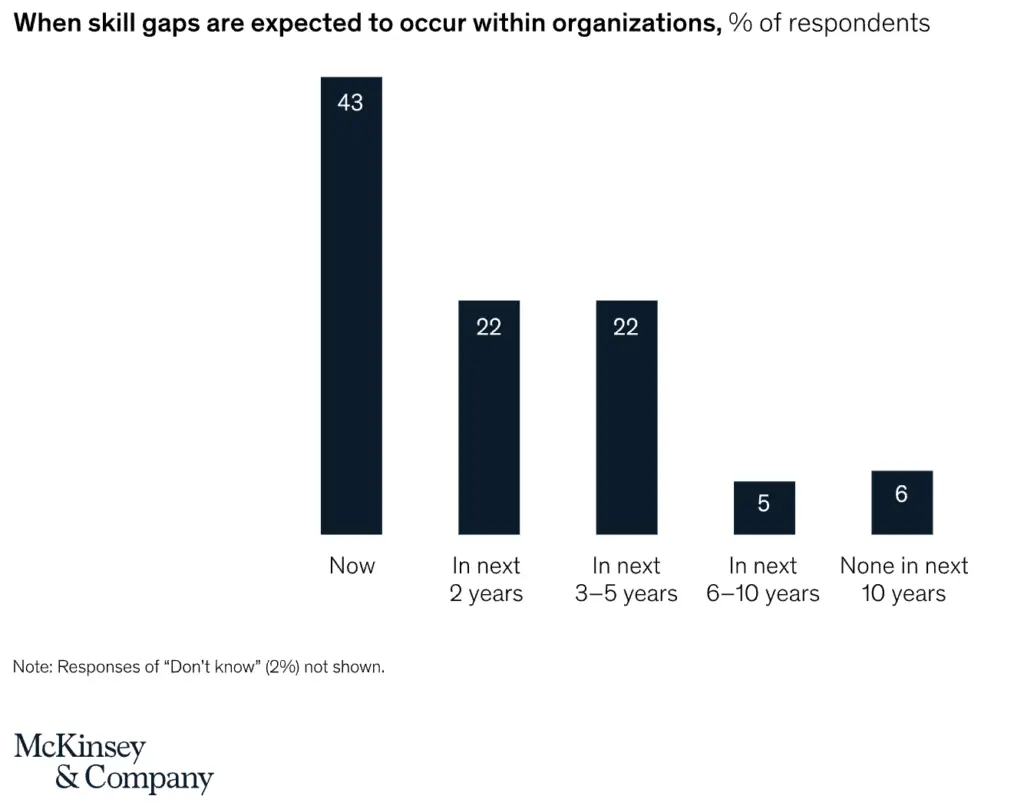A key principle in building any well-structured mentorship program is to start with the end in mind. Whether you’re rolling out a new training, setting business goals, or launching a mentoring initiative, knowing what success looks like from the beginning makes all the difference. The same holds true when defining your mentoring program objectives—clear, measurable outcomes help guide the entire journey. And when those objectives are tied to personal and professional growth, both for junior mentors and experienced mentors, you’re more likely to create a truly effective mentorship program that supports your people, strengthens employee engagement, and builds lasting mentoring connections. Emphasizing the mutual benefits for both the mentee and mentor can foster a collaborative environment. Additionally, aligning the mentoring program with the company’s culture is crucial for maximizing its benefits.
Effective communication skills are crucial in mentoring programs. They help mentors and mentees establish clear goals, foster relationships, and facilitate knowledge transfer, which are essential for the success of the mentoring relationship.
We’ve found that the most successful mentoring programs within our client community leverage this idea. When successful admins are in the ideation process, they universally focus on having mentoring program objectives serving as a strong foundation and planning out how they will gather, measure, and respond to their data insights.
To help avoid situations where your mentoring programs aren’t aligned with your business needs, we recommend making sure your program objectives fit the following criteria:
- They’re aligned with a specific business need
- They’re measurable
- You know how to measure them
- They’ll provide you with data that you can actually use
This post is all about helping you align your mentoring strategy with meaningful business outcomes. While every organization has unique goals, the mentoring program objectives outlined below are the most common—and most impactful—we’ve seen across successful mentorship initiatives. Whether you’re launching a new mentorship program or refining an existing one, these objectives can guide your efforts, strengthen mentoring connections, and help you gain executive buy-in. They’re especially powerful when tied to larger goals like employee engagement, career development, and building a strong network of career mentors across your organization.
Introduction to Mentoring
Definition and Purpose
Mentoring is a powerful tool for personal and professional development, where an experienced individual, known as a mentor, guides and supports a less experienced individual, known as a mentee. Constructive feedback plays a crucial role in this process, aiding personal development and fostering self-awareness and continuous improvement for the mentee. Having an experienced mentor is essential, as they can effectively guide the mentee through challenges and help them achieve their goals while building trust and rapport. The purpose of mentoring is to facilitate knowledge sharing, skill development, and career advancement, ultimately leading to a successful mentoring relationship. Effective mentoring programs can have a significant impact on both the mentor and mentee, leading to increased job satisfaction, improved leadership skills, and enhanced career growth. By fostering a supportive environment, mentoring relationships help individuals navigate their career paths, overcome challenges, and achieve their professional goals.
Benefits of Mentoring Programs
Advantages for Employees
Mentoring programs offer numerous benefits for employees, including career development, skill development, and leadership skills. These programs can support employee resource groups (ERGs) by providing a safe space for discussions, solidarity, and professional growth, particularly for underrepresented employees. These programs provide a platform for employees to learn from experienced mentors, gain valuable insights, and develop new skills. Mentoring programs can also lead to increased employee engagement, improved job satisfaction, and reduced turnover rates. Furthermore, mentoring programs can help employees achieve their career goals, advance in their careers, and develop a sense of personal and professional growth. By participating in a mentoring program, employees can build strong mentoring connections, receive career guidance, and empower employees to perform at their best, enhancing their overall professional development.
Setting Objectives for Mentoring Programs
Clear Goals and Outcomes
Setting clear objectives is essential for a successful mentoring program. A well-defined mentoring program with specific goals and outcomes helps to ensure that both mentors and mentees understand what is expected of them and what they can achieve through the mentoring relationship. Clear goals and outcomes also enable program participants to track progress, identify areas for improvement, and make adjustments as needed. Effective mentoring programs typically have objectives that align with the organization’s overall mission and goals, such as career development, leadership skills, and employee retention. By setting clear objectives, mentoring programs can help to foster a positive workplace culture, promote employee growth and development, and drive business success.
What Are Mentoring Program Objectives?
Mentoring program objectives are any measurable outcome you want to see from launching and running the program. Because an objective can simply be defined as “something you want to achieve,” by extension, the objective of a mentoring program will be “something you want to achieve through the use of a structured mentoring strategy.”
Formal mentoring programs are essential in achieving these measurable outcomes by providing clearly defined objectives, timelines, and methodologies that ensure effective mentorship and significant personal and professional development for mentees.
As simple as that is, you won’t be able to effectively determine what the objective should be unless you already have data to look at before starting.
When you launch mentoring programs, they should be aligned with specific business goals or objectives. But you should have data related to those goals or objectives that inform why a mentoring program can solve that area of need. Additionally, mentor goals should align with these business objectives, ensuring that mentors are not only guiding mentees but also enhancing their own leadership and communication skills.
There’s a multi-step planning process you may want to use to root this out:
- Consult with your executive team or representatives from the C-suite: Meet with executive leaders for insights on current business challenges. Determine which of these are challenges that mentoring can address
- Data review: Analyze existing data to understand areas of concern highlighted by leadership.
- Strategic alignment: Align potential mentoring objectives with overall business strategy.
- Set priorities: Prioritize areas where mentoring can have the most impact in the shortest amount of time.
- Ask for and incorporate feedback: Use feedback from various stakeholders to refine objectives.
Mentoring program objectives should be data-driven from the very beginning. Start by analyzing your internal metrics to identify where opportunities or gaps exist—whether in employee engagement, leadership skills, or professional development. From there, align those needs with what a strategic mentorship program can achieve. A well-crafted mentoring strategy connects the dots between organizational goals and people development, helping you plan for how mentoring connections and career mentors can effectively address challenges and drive measurable impact.
Introducing the concept of the mentoring journey is crucial. A seamless mentoring journey, facilitated by digital tools, ensures that both mentors and mentees can engage effectively, fostering stronger relationships and professional growth.
With that in mind, the most common successful mentoring program objectives we see across our clients focus on the following business needs:
- Employee retention
- Skill development
- Employee engagement
- Diversity, Equity, Inclusion, and Belonging (DEIB)
- Career development
While companies may assess these areas differently, most discover a clear need for improvement across the board. Aligning your mentoring program objectives with broader goals—such as strengthening your mentoring strategy, improving employee engagement, or building a more inclusive company culture—can significantly increase internal buy-in. Establishing clear communication channels and a plan for tracking progress is essential for participants to monitor their goals, expectations, and overall development throughout the program. When you demonstrate how your mentorship program will support outcomes like stronger mentoring connections, development of career mentors and junior mentors, or scalable peer mentoring formats, you lay the foundation for a more successful mentoring initiative.
Objective 1: Increase Employee Retention
Here’s the good news: The Great Resignation is officially, at least in the United States. By the end of 2023, U.S. quit rates were back to their pre-pandemic numbers. The bad news: Employee turnover was already on an upward trend in 2019; all it’s done is return to that trend line.

It’s fitting, then, that we can drum up Gallup’s 2019 on the high cost of turnover, which it called a $1 trillion problem that year. Employee retention remains one of the biggest problems and largest headaches for companies. Tech industry layoffs and downsizing aside, many other industries are struggling to retain workers. Retention can cost between 0.5 to 2X an employee’s salary, depending on the industry, specialization, and job level.
Meanwhile, it can take months to replace employees who quit, leading to a loss of productivity that can significantly reduce revenue generation.
Here’s the kicker: Almost any mentoring program can help you lower turnover. Structured programs, in particular, can be highly effective in reducing employee turnover by providing clear guidelines and support for both mentors and mentees. The question is whether lowering turnover will be a primary or secondary objective for the program. Either way, you should highlight retention as an objective to your programs, and track data associated with turnover.
How do I incorporate employee retention into my program?
The best way to make sure your program impacts employee retention is by targeting the individuals or groups within your organization that have the highest turnover rates. You should work together with HR professionals to examine retention data and exit survey data.
From there, your plan of attack will be to determine what types of programs these populations most need or want that will encourage them to stay at your company longer. At the same time, we’ve found that most mentoring programs have a net positive impact on employee retention, career development programs tend to be the most popular.
How do I use employee retention data to prove program success?
There are multiple strategies you can take to measure the impact of a mentoring program on employee retention:
- Examine the retention of mentoring program participants vs non-participants. This is a great strategy to use for voluntary programs where only a certain percentage of the target population is enrolled. (Quantitative)
- Examine the retention of the target group from before the program existed and then after the program’s first cycle has ended. This is a great strategy when your mentorship program is mandatory for the target population. (Quantitative)
- Comparison with Industry Averages: Compare your company’s retention rates against industry averages before and after implementing the mentorship program. (Quantitative)
- Collect feedback from both mentors and mentees about the program’s perceived impact on their decision to stay with the company. (Qualitative)\
Most of your data collection for tracking mentoring program objectives will be quantitative—and that’s a strong foundation. Those hard numbers tell a compelling story. However, combining that with employee feedback through surveys can help paint a more complete picture of your mentoring experience. For instance, if your mentorship program participants show a 50% higher retention rate than non-participants, but only 2% cite the mentoring program as a reason for staying, it may suggest other aspects of company culture or employee engagement are influencing outcomes. Blending qualitative insights with your participation data ensures your mentoring strategy remains aligned with what truly drives a successful program.
Objective 2: Upskill Employees
The Great Resignation may be over, but that doesn’t mean companies have all the skilled labor they need to get the job done. In 2021, McKinsey found that 65% of companies expected to have a skills gap either right now or in the next 2 years. Another 22% reported they’d have a skills gap in the next 3-5 years from the time the survey was conducted. Mentoring programs can play a crucial role in addressing these skills gaps by facilitating skills development. Through mentoring, employees can achieve career goals and acquire new skills, fostering a supportive environment for overall professional advancement.
Mentoring circles, a peer-to-peer format, can further enhance skills development by promoting group learning among employees with shared interests or objectives. These circles encourage cross-departmental and generational interaction, enhancing institutional knowledge and fostering a sense of belonging within organizations.

How are they doing on that end? Not so great.
In its 2023 Future of Jobs report, the World Economic Forum found that companies reported just 41% of their employees bridged skills gaps with additional training. That’s down slightly from 2023. The organization also notes that “formulating effective reskilling and upskilling strategies for the next five years is essential for maximizing business performance.”
Even if your company has upskilled some of its workers, it likely hasn’t upskilled all of them. Its ability to be competitive in the market going forward is going to be dictated not by how well it can hire increasingly difficult-to-find high-skilled talent but by how well it helps existing employees upskill and learn on the job, preparing them to assume leadership roles within their respective fields.
How do I incorporate upskilling into my program?
Mentoring and upskilling go hand-in-hand. You can easily make upskilling a key objective for your mentoring program when you design the program for that purpose. While upskilling can come naturally within other mentoring programs, you’re likely to get the best results when your program structure is focused on skill development and knowledge transfer. Mentoring programs facilitate knowledge transfer by allowing experienced mentors to impart their expertise to less experienced mentees, enhancing professional growth and career development through regular interactions and targeted learning sessions.
Begin by doing the following:
- Conducting a detailed skills gap analysis
- Utilizing data from performance reviews, employee surveys, and industry trends
- Collaborate with HR and department heads to align the mentoring program needed skills
- Identify individuals within the company who possess those skills and the individuals who need those skills
- Design the mentoring program to include specific tracks or pathways focused on these key skills, ensuring a targeted and effective approach
Matching the skill-haves with the skill-nots is not always easy. However, when using mentor matching software (mentoring software), you can dramatically reduce the time, effort, and difficulty of answering these questions and making those pairs. All it takes is setting up your enrollment survey to focus on skills. Then, when you run your mentoring software to match participants, you can focus on pairing individuals based on these skill gaps.
But what happens when you have far more mentors than mentees? That’s going to be a common problem in any mentoring program, but especially one where you’re trying to upskill employees. The answer may be to focus on different mentoring formats, such as group mentoring or shorter-term flash mentoring/micro mentoring
How do I use upskilling data to prove program success?
There’s always a bit of angst around how to measure existing employee’s skills and knowledge quantitatively. While giving job candidates skills and knowledge tests is commonplace, this is far less common for existing employees. You could try to implement internal skills testing, but don’t be surprised if you face a lot of pushback, especially if employees are afraid that their skill gaps will be used against them.
Nevertheless, insightful ways exist to measure employee skill development without forcing them to take skills assessments. These can include:
- Having employees rate their level of familiarity with different skills with pre- and post-mentoring surveys. (Qualitative)
- Have managers rate their teams’ familiarity with different skills using pre- and post-mentoring surveys. (Qualitative)
- Measure productivity or output from employees pre- and post-mentoring. (Quantitative)
That last one is the more challenging of the three. After all, how does one measure productivity? Here are a few ways to go about that one:
- Measure output: Assess the quantity of work completed before and after the mentoring program. This could be the number of tasks completed, sales volume, or project deliverables. (Quantitative)
- Track efficiency: Look at the time taken to complete specific tasks or projects. An improvement in efficiency post-mentoring indicates enhanced skills. (Quantitative)
- Measure goal achievement: Monitor the achievement of individual and team goals related to specific skills or projects. (Quantitative)
- Measure output quality: Evaluate the quality of work through peer reviews, customer feedback, or error rates. Improved quality suggests better skills application. (Qualitative)
Sales mentorship programs are a great example of where a before and after can be seen very clearly. If mentoring program participants in a Sales Mentoring Program see an increase in landing deals after they’ve upskilled in the program, that’s a good sign that it’s working.
Objective 3: Support Career Development
reer development is intricately tied with retention and skill development, but it can be considered its own unique objective. Companies should focus on career development for several reasons, including helping employees recognize and advance their career trajectory. Structured mentoring programs play a crucial role in this by guiding employees in their skill development and overall career advancement. This quote from an MIT Sloan article nicely sums up its importance:
“Sixty-seven percent of the individual contributors surveyed said they want to advance their career, but 49% said a lack of good career advice has hurt their job trajectory. Too often, executives ask employees to chart their own paths under the guise of empowerment, leaving them aimless.”
Particularly among U.S. workers, the desire for upward mobility at work is particularly strong. The fear of getting stuck in a “dead-end job” is also particularly strong, given its consistent appearance in popular culture, such as movies (like “Office Space”) and TV shows (particularly “The Office”).
Get a first-hand perspective on how career development works with a DEI focus directly from Fortune 500 Europe company Publicis. Want more insights like this live? Sign up for our Virtual MentorCom events!
How do I incorporate career development into my program?
While employee retention may not be the sole foundation of a mentoring program, skill development often is. Career development can land in either category. Some mentorship programs naturally support career growth—especially when mentoring connections lead to sponsorship opportunities with experienced mentors. Alternatively, companies may choose to prioritize and formalize career growth by designing dedicated career mentoring tracks within their mentoring strategy. These programs can play a crucial role in identifying and nurturing future leaders within the organization. By facilitating professional development for mentees and allowing mentors to impart their knowledge while enhancing their leadership skills, mentoring programs create a pathway for career advancement and improved organizational culture.
Introducing reverse mentoring, where junior employees mentor senior colleagues, can also provide unique benefits by facilitating the sharing of contemporary skills and workplace insights.
Either approach can work, although the structured approach is likely to get more directly measurable results.
To make career development a key objective in your mentoring strategy, begin by:
- Mapping out clear career pathways within your organization
- Working closely with HR to understand various career trajectories and the skills needed for each
- Designing your mentoring program to align with these paths
- Matching mentees with mentors who have experience in desired career directions
Mentoring programs specifically designed to support junior employees can significantly boost their growth and retention. By helping junior employees gain essential skills, integrate into company culture, and receive guidance from more experienced colleagues, these programs ensure a well-rounded development experience.
Your matching strategy will come into play here again. When you make career development and career pathing questions part of the enrollment survey, you give yourself the flexibility to effectively match participants across various needs, including the type of career they want to pursue within your organization.
How do I use career development data to prove program success?
There are two clear ways to tie your mentoring programs to career development objectives:
- Promotion and internal movement data (participants vs non-participants). (Quantitative)
- Feedback surveys for promoted employees.
Track the career progression of mentees before and after the mentoring program. This can include promotions, transitions to new roles within the organization, and expanded job responsibilities. Additionally, conduct surveys to assess employees’ satisfaction with their career growth post-mentoring.
Measuring Success Beyond Promotions
While promotions are a clear indicator of career advancement, also consider the development of soft skills like leadership, communication, and strategic thinking. Surveys and 360-degree feedback can provide insights into these areas.
Implementing a Mentoring Program
Key Steps and Considerations
Implementing a successful mentoring program requires careful planning and consideration. Program managers play a crucial role in the success of mentoring programs by celebrating achievements, defining clear objectives using frameworks like OKRs, and ensuring meaningful mentor-mentee pairings. The first step is to define the purpose and goals of the program, including the target audience, program objectives, and desired outcomes. Next, it is essential to identify potential mentors and mentees, considering factors such as experience, skills, and career goals. A well-structured mentorship program should include regular meetings, feedback mechanisms, and opportunities for growth and development. Additionally, program organizers should establish clear guidelines and expectations, provide training and support for mentors and mentees, and continuously evaluate and improve the program. By following these key steps and considerations, organizations can create a good mentoring program that is closely aligned with the company’s overall objectives and goals, benefiting both mentors and mentees, and leading to a positive impact on the company culture and overall success.
Best Practices for Mentoring
Tips and Strategies
To establish a successful mentoring program, it’s crucial to follow best practices and implement effective strategies. One key tip is to provide training and support for both mentors and mentees, ensuring they understand their roles and responsibilities within the mentoring relationship. Another strategy is to establish a formal mentoring program with clear guidelines, expectations, and evaluation metrics. This helps to ensure that the program is well-structured and effective in achieving its objectives. Additionally, mentoring programs should prioritize diversity, equity, and inclusion, providing opportunities for underrepresented groups to participate and benefit from the mentoring experience. By following these best practices and tips, organizations can create a successful mentoring program that drives career development, leadership skills, and employee engagement.
Overcoming Challenges in Mentoring
Common Obstacles and Solutions
Despite the many benefits of mentoring, programs can face various challenges and obstacles. One common issue is finding and matching suitable mentors and mentees, which can be addressed by using mentoring software or implementing a formal mentoring program with clear guidelines and expectations. Another challenge is ensuring that mentors and mentees are committed to the mentoring relationship and are actively engaged in the process. This can be overcome by providing regular check-ins, feedback, and evaluation metrics to track progress and identify areas for improvement. Furthermore, mentoring programs may encounter difficulties in measuring program success and ROI, which can be addressed by establishing clear objectives and outcomes, tracking key performance indicators, and conducting regular evaluations. By understanding these common obstacles and implementing effective solutions, organizations can overcome challenges and establish a successful mentoring program that drives business success and employee growth.
Successfully Meeting Objectives Requires the Right Tools
Mentoring produces incredible results, but only if you have the right tools. Trying to manually run programs is one of the common reasons we’ve seen that results in ineffective and poorly measurable results. Utilizing a mentorship platform to manage and measure mentoring program objectives is crucial. When you take a software-based approach to aligning and measuring mentoring program objectives, all of the following are made possible:
- Easily scaled programs, allowing you to impact a larger population of employees
- Science-based matching, resulting in better quality matches and better program outcomes
- Automated data collection and analysis, ensuring you have all of the data you need right at your fingertips, without having to spend days or weeks trying to collect and parse it yourself
Think about how difficult launching, matching, and measuring the success of your mentoring programs would be if you were stuck in Excel spreadsheets. It’s a scary thought, to say the least. But that’s why some of the largest and most profitable and data-driven companies in the world, including Disney, T. Rowe Price, Hilton, Sony, and LinkedIn, have all turned to MentorcliQ to help them create more successful and more impactful mentoring programs.
See for yourself with a quick demo and be sure to sign up for an upcoming MentorCom event!




